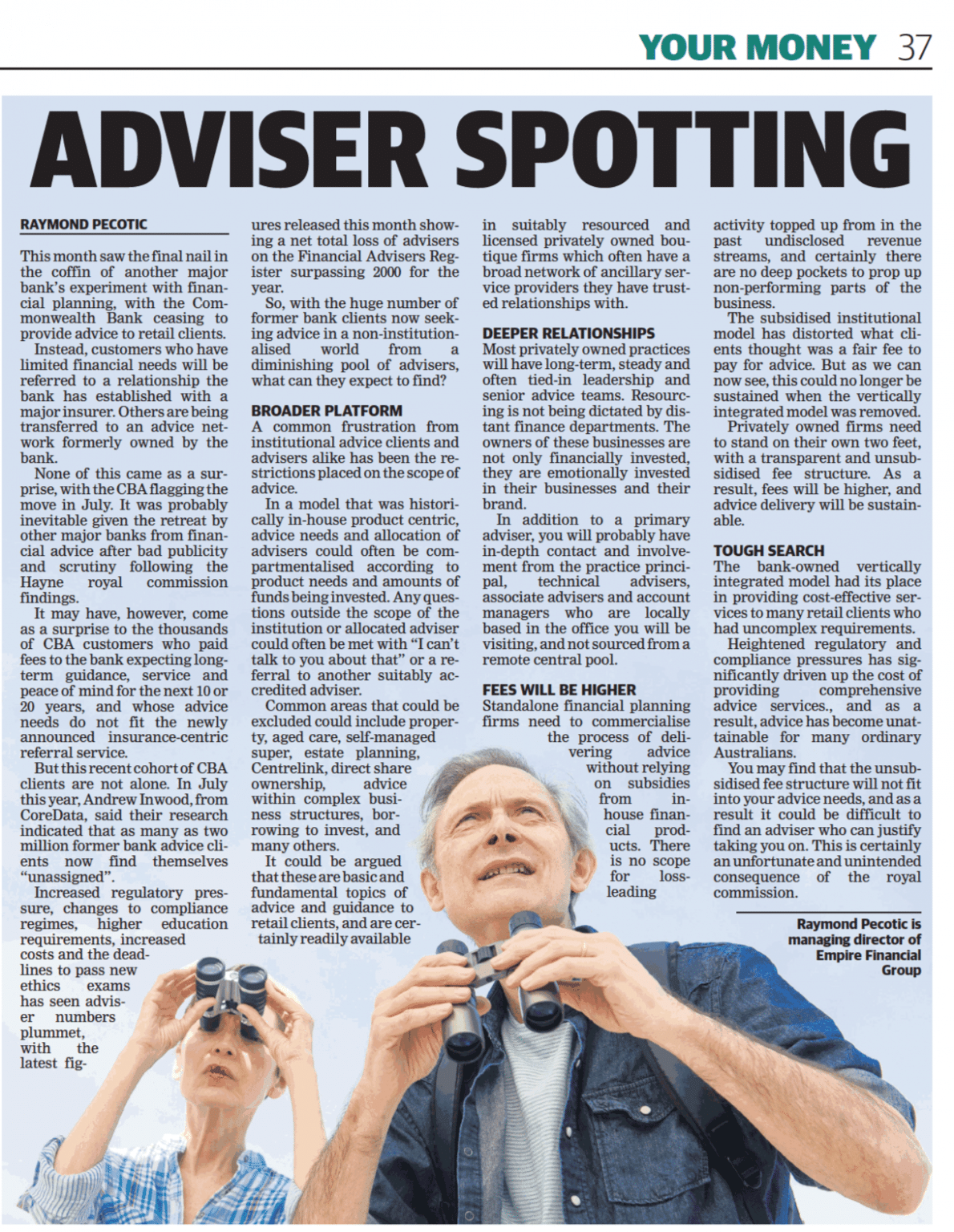By Raymond Pecotic, Managing Director, Empire Financial Group.
This article first appeared in The West Australian, Your Money, on the 13th December 2021
This month saw the final nail in the coffin of another major bank’s experiment with financial planning, with the Commonwealth Bank ceasing to provide advice to retail clients.
Instead, customers who have limited financial needs will be referred to a relationship the bank has established with a major insurer. Others are being transferred to an advice network formerly owned by the bank.
None of this came as a surprise, with the CBA flagging the move in July. It was probably inevitable given the retreat by other major banks from financial advice after bad publicity and scrutiny following the Hayne royal commission findings.
It may have, however, come as a surprise to the thousands of CBA customers who paid fees to the bank expecting longterm guidance, service and peace of mind for the next 10 or 20 years, and whose advice needs do not fit the newly announced insurance-centric referral service.
But this recent cohort of CBA clients are not alone. In July this year, Andrew Inwood, from CoreData, said their research indicated that as many as two million former bank advice clients now find themselves “unassigned”.
Increased regulatory pressure, changes to compliance regimes, higher education requirements, increased costs and the deadlines to pass new ethics exams has seen adviser numbers plummet, with the latest figures released this month showing a net total loss of advisers on the Financial Advisers Register surpassing 2000 for the year.
So, with the huge number of former bank clients now seeking advice in a non-institutionalised world from a diminishing pool of advisers, what can they expect to find?
BROADER PLATFORM
A common frustration from institutional advice clients and advisers alike has been the restrictions placed on the scope of advice.
In a model that was historically in-house product centric, advice needs and allocation of advisers could often be compartmentalised according to product needs and amounts of funds being invested. Any questions outside the scope of the institution or allocated adviser could often be met with “I can’t talk to you about that” or a referral to another suitably accredited adviser.
Common areas that could be excluded could include property, aged care, self-managed super, estate planning, Centrelink, direct share ownership, advice within complex business structures, borrowing to invest, and many others.
It could be argued that these are basic and fundamental topics of advice and guidance to retail clients, and are certainly readily available in suitably resourced and licensed privately owned boutique firms which often have a broad network of ancillary service providers they have trusted relationships with.
DEEPER RELATIONSHIPS
Most privately owned practices will have long-term, steady and often tied-in leadership and senior advice teams. Resourcing is not being dictated by distant finance departments. The owners of these businesses are not only financially invested, they are emotionally invested in their businesses and their brand.
In addition to a primary adviser, you will probably have in-depth contact and involvement from the practice principal, technical advisers, associate advisers and account managers who are locally based in the office you will be visiting, and not sourced from a remote central pool.
FEES WILL BE HIGHER
Standalone financial planning firms need to commercialise the process of delivering advice without relying on subsidies from inhouse financial products. There is no scope for lossleading activity topped up from in the past undisclosed revenue streams, and certainly there are no deep pockets to prop up non-performing parts of the business.
The subsidised institutional model has distorted what clients thought was a fair fee to pay for advice. But as we can now see, this could no longer be sustained when the vertically integrated model was removed.
Privately owned firms need to stand on their own two feet, with a transparent and unsubsidised fee structure. As a result, fees will be higher, and advice delivery will be sustainable.
TOUGH SEARCH
The bank-owned vertically integrated model had its place in providing cost-effective services to many retail clients who had uncomplex requirements.
Heightened regulatory and compliance pressures has significantly driven up the cost of providing comprehensive advice services., and as a result, advice has become unattainable for many ordinary Australians.
You may find that the unsubsidised fee structure will not fit into your advice needs, and as a result it could be difficult to find an adviser who can justify taking you on. This is certainly an unfortunate and unintended consequence of the royal commission.
Raymond Pecotic is managing director of Empire Financial Group



